Diploblastic - Study guides, Class notes & Summaries
Looking for the best study guides, study notes and summaries about Diploblastic? On this page you'll find 55 study documents about Diploblastic.
Page 3 out of 55 results
Sort by
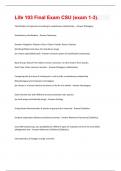
-
Life 103 Final Exam CSU (exam 1-3)Graded A Q&A Complete
- Exam (elaborations) • 15 pages • 2024
- Available in package deal
-
- $7.99
- + learn more
Classification of organisms according to evolutionary relationships. - Answer-Phylogeny Evolutionary classification - Answer-Taxonomy Domain> Kingdom> Phylum> Class> Order> Family> Genus> Species (Did King Phillip Come Over For Grandma's Soup) [ex. Homo sapien](italicized) - Answer-Linnaean system of classification (taxonomy) Basal Group: Branch from oldest common ancestor, no other branch from species. Sister Taxa: Share common ancestor - Answer-Phylogeny relationshi...
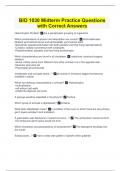
-
BIO 1030 Midterm Practice Questions with Correct Answers
- Exam (elaborations) • 5 pages • 2024
-
Available in package deal
-
- $8.99
- + learn more
Heterotrophic Protists? Are a paraphyletic grouping of organisms Which combinations of phylum and description are correct? -Echinodermata: bilateral symmetrical larvae and pentaradially symmetrical adult -Nematoda: pseudocoelomates with both parasitic and free living representatives -Cnidaria: radially symmetrical with cnidocytes -Platyhelminthes: parasitic and free-living acoelomates Which characteristics are found in all chordates: -notochord: structural support, skeleton, -dorsal, hollow ne...

-
TAMU BIOLOGY 112 EXAM #3 Questions and Answers 100% Pass
- Exam (elaborations) • 33 pages • 2024
-
- $13.49
- + learn more
TAMU BIOLOGY 112 EXAM #3 Questions and Answers 100% Pass Select the TRUE statement about animal development: A.) Deuterostome development is indeterminate. B.) Mesoderm in protostomes arises as outpocketings of the primitive gut. C.) Radial cleavage is characteristic of protostome development. D) In deuterostomes, the blastopore ultimately becomes the mouth of the adult. E) All of the above are true. - Answer- Deuterostome development is indeterminate. During embryogenesis of diploblasti...
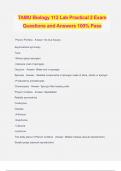
-
TAMU Biology 112 Lab Practical 2 Exam Questions and Answers 100% Pass
- Exam (elaborations) • 23 pages • 2024
-
- $12.49
- + learn more
TAMU Biology 112 Lab Practical 2 Exam Questions and Answers 100% Pass Phylum Porifera - Answer- No true tissues Asymmetrical symmetry Taxa: -Silicea (glass sponges) -Calcarea (rest of sponges) Osculum - Answer- Water exit in sponges Spicules - Answer- -Skeletal components of sponges made of silica, calcite or spongin -Produced by amoebocytes Choanocytes - Answer- Spong's filter-feeding cells Phylum Cnidaria - Answer- Diploblastic Radially symmetrical Cnidocytes Classes: -Anthozoa...
![ZOL1501 Exam Revision [2]](/docpics/5918886/66aa7f7316cbd_5918886_121_171.jpeg)
-
ZOL1501 Exam Revision [2]
- Exam (elaborations) • 2 pages • 2024
-
- $12.49
- + learn more
ZOL1501 Exam Revision [2] Choose the correct answer by choosing the number corresponding to the answer you have chosen. 1. Specialized archaeocytes that secrete spongin are called ___________. 1. collencytes 2. sclerocytes 3. choanocytes 4. spongocytes 5. lophocytes 2. Which species of the genus Schistosoma is found in the veins of the large intestine of the human being __________. 1. S. mansoni 2. S. japonicum 3. S. haematobium 4. S. plumula 5. S. hepati...
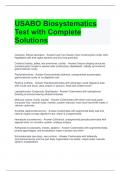
-
USABO Biosystematics Test with Complete Solutions
- Exam (elaborations) • 2 pages • 2024
-
- $12.99
- + learn more
USABO Biosystematics Test with Complete Solutions Calcarea, Silicea (sponges) - Answer-Lack true tissues; have choanocytes (collar cells-flagellated cells that ingest bacteria and tiny food particles) Cnidaria (hydras, jellies, sea anemones, corals) - Answer-Unique stinging structures (nematocysts) housed in special cells (cnidocytes); diploblastic, radially symmetrical, gastrovascular cavity Plathyhelminthes - Answer-Dorsoventrally flattened, unsegmented acoelomates; gastrovascular cavit...
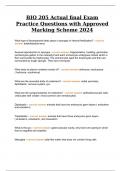
-
BIO 205 Actual final Exam Practice Questions with Approved Marking Scheme 2024
- Exam (elaborations) • 30 pages • 2024
-
Available in package deal
-
- $12.99
- + learn more
BIO 205 Actual final Exam Practice Questions with Approved Marking Scheme 2024 What type of development takes place in sponges in internal fertilization? - correct answer amphiblastula larva Asexual reproduction in sponges - correct answer fragmentation, budding, gemmules (archeocytes gather in the mesophyll and each archeocyte undergoes mitosis which is then surrounded by trophocytes. The archeocytes egult the trophocytes and then are surrounded by tough spongin. They have micropyle. Wha...

-
Biology 1108 Exam 3 Questions and Answers (Latest Update) 120 Questions | Graded A+
- Exam (elaborations) • 21 pages • 2023
-
- $15.49
- + learn more
Biology 1108 Exam 3 Questions and Answers (Latest Update) 120 Questions | Graded A+. Alpine - Correct Answers Similar to Tundra, Lacks permafrost, Budding - Correct Answers Form of asexual reproduction in which a bud/protrusion forms on an organism and eventually breaks off to form a new organism that is smaller than its parent. Fragmentation - Correct Answers A type of asexual reproduction in which one organism is broken into pieces, each of which develops into a new individual Partheno...
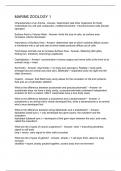
-
Marine Zoology #1
- Exam (elaborations) • 3 pages • 2024
-
- $9.99
- + learn more
Characteristics of an Animal - Answer- heterotroph (eat other organisms for food), multicellular (no cell wall, eukaryotic), motility/movement, *neurons/muscle cells (except sponges) Surface Area to Volume Ratio - Answer- limits the size of cells, as surface area increases volume decreases Importance of Surface Area - Answer- determines rate at which nutrients diffuse across a membrane into a cell and rate at which waste products diffuse out of cells Techniques Animals use to Increase S...
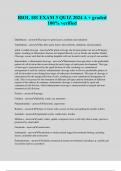
-
BIOL 181 EXAM 3 QUIZ 2024 A + graded 100% verified
- Exam (elaborations) • 4 pages • 2024
- Available in package deal
-
- $10.49
- + learn more
BIOL 181 EXAM 3 QUIZ 2024 A + graded 100% verified Diploblastic - answerhaving two germ layers; ectoderm and endoderm Triploblastic - answerhas three germ layers: the ectoderm, endoderm, and mesoderm. spiral vs radial cleavage - answerIn spiral cleavage, the division planes are not at 90 degree angles, resulting in blastomeres that are not aligned directly over or beside one another. Radial Cleavage: occurs such that the resulting daughter cells are located exactly on top of one another. ...

Do you wonder why so many students wear nice clothes, have money to spare and enjoy tons of free time? Well, they sell on Stuvia! Imagine your study notes being downloaded a dozen times for $15 each. Every. Single. Day. Discover all about earning on Stuvia


